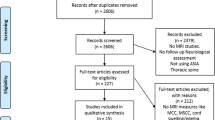Summary
To analyze MR manifestations of postoperative spinal complications and investigate the value of MRI in the diagnosis and differentiated diagnosis, 114 cases of spinal postoperative complications were analyzed retrospectively and compared with the clinical data. The results showed that the main postoperative spinal complications included spinal stenosis (n=33, consisting of 21 cases of epidural fibrosis and 12 cases of epidural hematoma or epidural abscess), lack of spinal stability (n=43), infection (n=23, consisting of 7 cases of para-spinal soft-tissue infection, 5 cases of vertebral discitis, 4 cases of vertebral and appendix infection, 3 cases of epidural abscess, 2 cases of myelitis, 2 cases of spinal arachnoiditis), others (n=28, consisting of 12 cases of inner fixation failure, 9 cases of epidural hematoma, 7 cases of cerebrospinal fluid gusher). It is concluded that MRI can specifically display all kinds of postoperative spinal complications, and is of significant value in the diagnosis and differentiated diagnosis of postoperative spinal complications.
Similar content being viewed by others
References
Hueftle MG, Modic MT, Ross JS, et al. Lumbar spine: postoperative MR imaging with Gd-DTPA. Radiology, 1988,167(3):817–824
Haughton V, Schreibman K, Smet AD. Contrast between scar and recurrent herniated disk on contrast-enhanced MR images. AJNR, 2002,23(10):1652–1656
Bundshuh CV, Stein L, Slusser JH, et al. Distinguishing between scar and recurrent herniated disc in postoperative patients: value of contrast-enhanced CT and MR imaging. Am J Neuroradiol, 1990,11(5):949–958
Sarrazin JL. Imaging of postoperative lumbar spine. J Radiol, 2003,84(2 Pt 2):241–250
Murray JG, Stack JP, Ennis JT, et al. Digital subtraction in contrast-enhanced MR imaging of the postoperative lumbar spine. AJR, 1994,162(4):893–898
Sen O, Kizilkilic O, Aydin MV, et al. The role of closed-suction drainage in preventing epidural fibrosis and its correlation with a new grading system of epidural fibrosis on the basis of MRI. Eur Spine J, 2005,14(4): 409–414
Sokolowski MJ, Garvey TA, Perl J II, et al. Postoperative lumbar epidural hematoma: does size really matter? Spine. 2008,33(1):114–119
Hans P, Delleuze PP, Born JD, et al. Epidural hematoma after cervical spine surgery. J Neurosurg Anesthesiol, 2003, 15(3):282–285
Bommireddy R, Kamat A, Smith ET, et al. Magnetic resonance image findings in the early post-operative period after anterior cervical discectomy. Eur Spine J, 2007,16(1):27–31
Satomi K, Ogawa J, Ishii Y, et al. Short-term complications and long-term results of expansive open-door laminoplasty for cervical stenotic myelopathy. Spine J, 2001,1(1):26–30
Dufour V, Feydy A, Rillardon L, et al. Comparative study of postoperative and spontaneous pyogenic spondylodiscitis. Semin Arthritis Rheum, 2005, 34(5):766–771
Van Goethem JW, Parizel PM, van den Hauwe L, et al. The value of MRI in the diagnosis of postoperative spondylodiscitis. Neuroradiology, 2000,42(8):580–585
Lohr M, Reithmeier T, Ernestus RI, et al. Spinal epidural abscess: prognostic factors and comparison of different surgical treatment strategies. Acta Neurochir, 2005, 147(2):159–166
Koerts G, Rooijakkers H, Abu-Serieh B, et al. Postoperative spinal adhesive arachnoiditis presenting with hydrocephalus and cauda equina syndrome. Clin Neurol Neurosurg, 2008,110(2):171–175
Matsui H, Tsuji H, Kanamori M, et al. Laminectomy-induced arachnoradiculitis: a postoperative serial MRI study. Neuroradiology, 1995,37(8):660–666
Seichi A, Takeshita K, Kawaguchi H, et al. Postoperative expansion of intramedullary high-intensity areas on T2-weighted magnetic resonance imaging after cervical laminoplasty. Spine, 2004,29(13):1478–1482
Hannallah D, Lee J, Khan M, et al. Cerebrospinal fluid leaks following cervical spine surgery. J Bone Joint Surg Am, 2008,90(5):1101–1105
Bosacco SJ, Gardner MJ, Guille JT. Evaluation and treatment of dural tears in lumbar spine surgery: a review. Clin Orthop Relat Res, 2001,389:238–247
Colak A, Kutlay M, Demircan N, et al. MR imaging for early complications of transpedicular screw fixation. Eur Spine J, 1999,8(2):151–155
Kast E, Mohr K, Richer HP, et al. Complications of transpedicular screw fixation in the cervical spine. Eur Spine J, 2006,15(3):327–34
Author information
Authors and Affiliations
Rights and permissions
About this article
Cite this article
Yang, H., Wang, R., Luo, T. et al. MRI manifestations and differentiated diagnosis of postoperative spinal complications. J. Huazhong Univ. Sci. Technol. [Med. Sci.] 29, 522–526 (2009). https://doi.org/10.1007/s11596-009-0426-4
Received:
Published:
Issue Date:
DOI: https://doi.org/10.1007/s11596-009-0426-4




